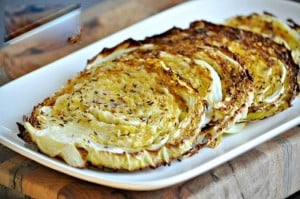Cabbage you will love

by Judy Palken MNS, RD, LDN
If I can get you to put cabbage onto your shopping list, I will consider this post to be a success! Cabbage is considered by many to be a nice, homey, vegetable - not usually anyone’s number-one favorite, definitely not trendy, but perhaps related to good memories of stuffed cabbage, or coleslaw at a summer barbeque.
Well, try this! This simple recipe will make you re-think cabbage if you haven’t been eating it - it is so delicious, and so easy!
Garlic Rubbed Roasted Cabbage Steaks
Ingredients: 
- 1 head green cabbage
- 2 Tbsp extra virgin olive oil
- 2 to 3 large garlic cloves, smashed
- Kosher salt (optional)
- black pepper
Directions:
- Preheat oven to 400 degrees F and line a baking sheet with parchment paper. Pull outer leaves off the cabbage, and cut it into 1" thick slices starting at the top (the end farthest from the root).
- Use a pastry brush to evenly spread olive oil over both sides of the cabbage slices.
- Rub both sides of each slice with garlic.
- Sprinkle each side with a bit of Kosher salt if desired, and black pepper.
- Roast on the middle rack of oven for 30 minutes. Carefully flip the cabbage steaks and roast for about an additional 30 minutes, checking to make sure they don’t start to burn at the edges.
Serve hot and enjoy!
Adapted from www.everydaymaven.com/2012/garlic-rubbed-roasted-cabbage-steaks/
I prepared this for my family, and it is not an exaggeration to say we were, um, fighting over the cabbage steaks. Well, three of us were (the fourth wouldn’t try them. There is always one. But I’ll keep working on him).
Cabbage is high in vitamin C, vitamin K, vitamin B-6, manganese, and fiber, and is also a good source of many other vitamins and minerals. It’s inexpensive and stores well - a perfect winter vegetable. Keep it in your fridge lightly wrapped, don’t wash till ready to use - come back to it over a week later, and it is still like new. It can keep a long time.
Cabbage is a member of the family of vegetables called Brassica, or Cruciferous vegetables. This family also includes broccoli, cauliflower, kale, bok choy, Brussels sprouts, broccoli rabe, and many others. Like other cruciferous vegetables, cabbage has cancer-fighting compounds. Savoy cabbage in particular is rich in sinigrin, a glucosinolate that gets converted in the body to a compound that seems to have preventative properties against bladder, colon and prostate cancer. Savoy cabbage is the one with the crinkly, textured leaves and contrasting shades of green, and is milder and sweeter than red or green cabbage.
By the way, each of these is indeed a specific type of cabbage - green cabbage is the typical, hard cabbage that most of us have some familiarity with, and raw red cabbage is also hard and rubbery, with a bolder flavor than green cabbage.
Red cabbage is especially rich in anthocyanins, which are great disease-fighting antioxidants and anti-inflammatory compounds - red cabbage is in fact one of the most nutritious vegetables you can eat. It is often used just as a garnish, or for a contrasting color, and that is a shame - we should all be eating it, in salad, coleslaw, any way we can.
Steaming is an excellent way to cook cabbage, and when steamed, it has been shown to help lower the harmful LDL-cholesterol. With steaming and sautéing more of the nutrients are preserved, when compared with longer-cooking methods.
Simple Steamed Cabbage
Ingredients:
- 1/2 head cabbage
- extra virgin olive oil
- salt if desired
- black pepper
Directions:
- Cut the 1/2 head of cabbage into 4 wedges.
- Place in a steamer, side by side, one cut side down.
- Steam for 6 minutes, turn, and steam for about 6-8 minutes more. Do not overcook.
- Drizzle lightly with olive oil. Add salt if desired, and pepper.
This recipe is very simple, but of course you can add to it visually and nutritionally by tossing in some slices of pepper, or any vegetable you like. Mushrooms are also a great addition.
It is important to mention that cabbage is a great prebiotic food - meaning that the fiber in it provides fuel for the good bacteria in our large intestines. So if you are making a point to feed your gut with foods containing good bacteria, like yogurt and kefir, be sure to feed the bacteria some good cabbage.
Note - sauerkraut that is unpasteurized is a great example of a food that is both a prebiotic (from the cabbage) and probiotic (because it is fermented, and has good bacteria). Enjoy cabbage often!

